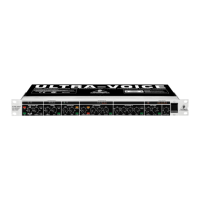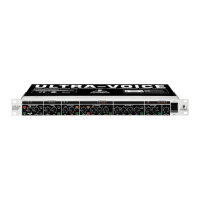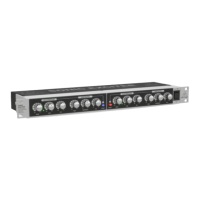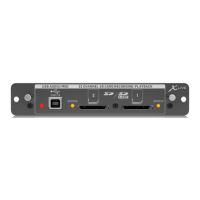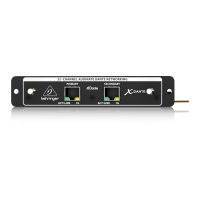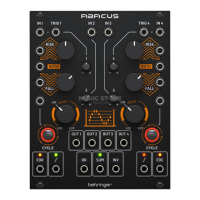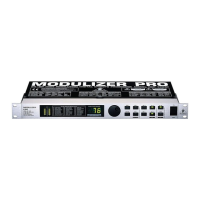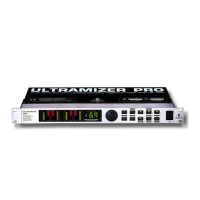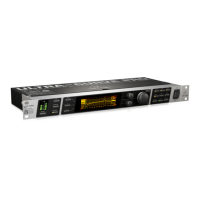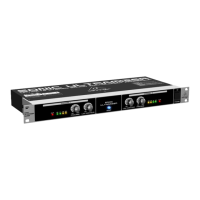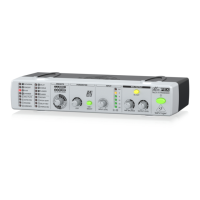12
from the right channel. In those cases EDITB ENGINEL or EDITB ENGINER means that you select
EDITB and the left or right engine. If we only state EDITB for instance then the selection of the left or right
engines does not play a role.
1.4.1 Reverb and delay algorithms
Cathedral: Reverb program that generates long and dense reverberation, much like the natural reverb
ambience found in churches or cathedrals. Particularly suitable for solo instruments and voices. Varia-
tion modifies the decay time, EDITA adjusts the differences between tiled and angular walls (diffusion),
while EDITBENGINEL governs the early reflections and EDITBENGINER the brilliance of the
reverb signal.
Plate: The sound of early reverb plates. The decay time can be set from 0-9 s using VARIATION.
EDITA determines the pre-delay by changing the perceived size of the room, EDITB uses ENGINEL
to enhance the stereo image and ENGINER to modify the room brilliance. A classic reverb program for
drums and solo voices.
Small Hall: Simulation of a small, highly reverberating hall. Use short reverb times (VARIATION) to
process drum instruments or medium reverb times to enhance wind instruments. EDITA controls diffu-
sion, EDITB early reflections (ENG.L) and stereo width (ENG.R).
Room: You can clearly hear the walls of this room as they are reflecting the sound. Their characteristics
can be changed with EDITB (from reflective (tiles, marble) to absorbent (carpets, curtains). Use VARIA-
TION (reverb time / room size) to create any room typefrom small store rooms to large living rooms.
EDITA governs the pre-delay. A useful program for reverb that isnt directly noticable (rap, hip hop
vocals) or to make dry recordings of instruments sound natural again. Very all-round effect.
Studio: Middle to large rooms that can be modified in their wall characteristics (EDITB, ENG.R), early
reflections (EDITBENG.L), position of sound source (= pre-delay: EDITA) and size (VARIATION).
Creates a natural and multipurpose sound.
Concert: Use VARIATION (reverb time) to create a small theater or large concert hall, determine the
distance to the stage (= predelay: EDITA), the distance to neighboring walls (= early reflections:
EDITBENG.L) and their structure (= diffusion: EDITBENG.R).
Stage: Wonderful reverb, for example, to provide keyboard pads or acoustic guitars with width and
depth (EDITBENG.R = stereo width), and to make them sound fresher (EDITBENG.L = bril-
liance). Additionally, you can set the reverb time with VARIATION and the diffusion with EDITA.
Designed for live applications and mixdown.
Vocal: Rich and dense reverb with middle reverb times (VARIATION) giving solo voices their finishing
touch. EDITA controls pre-delay, EDITBEng.L early reflections and EDITBENG.R brilliance.
Percussion: This dense reverb is characterized by pronounced early reflections which make it very
suitable for dynamic signals (drums, percussion, slap bass, etc.). Apart from diffusion (EDITA) and
reverb time (VARIATION) you can create interesting effects using the separately adjustable decay time
of high-frequency portions (EDITB), which make the reverb more, or less audible.
Stereo Delay: Here, the input signal is delayed by as much as 5.1 s. Use VARIATION for a rough
setting from 0 ms to 5.1 s. Use EDITA to adjust the delay time in milliseconds (in steps of 5 ms up to
VARIATION 6, then 10 ms). EDITB determines the amount of effect signal that is fed back to the effect
(input signal is repeated several times with decaying intensity). The maximum feedback is limited to
avoid feedback loops.
Stereo Ping-Pong Echo: Much like the delay effect, echo repeats the input signal with decaying
intensity. However, here the echoes lose brilliance with each repetition, which simulates the trendy
vintage effect produced by tape echo units that were widely used in the pre-digital era. Additionally, the
reflections are alternatingly routed to the left and right channels so as to produce a kind of stereo
effect.
1. INTRODUCTION
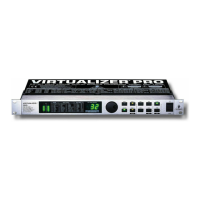
